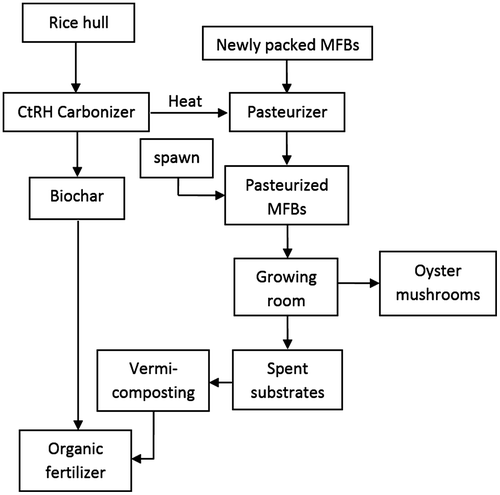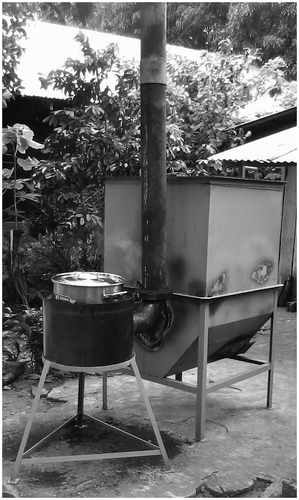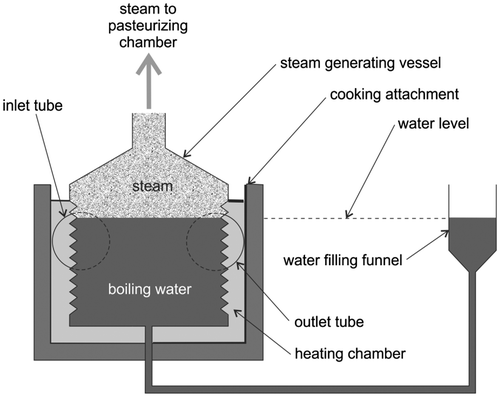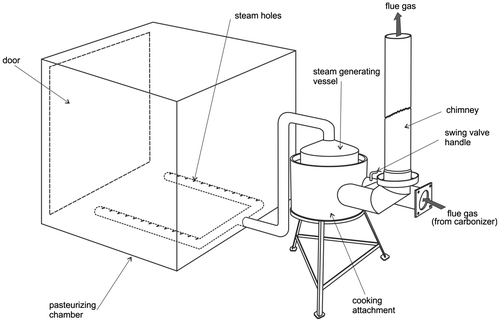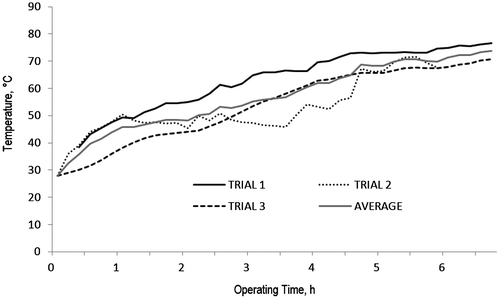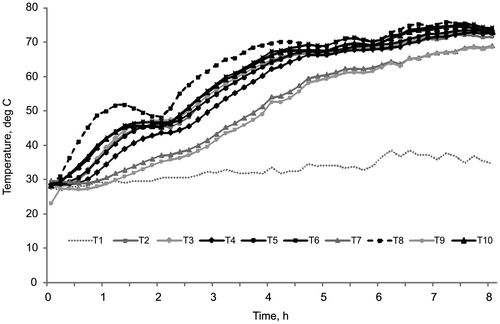 ?Mathematical formulae have been encoded as MathML and are displayed in this HTML version using MathJax in order to improve their display. Uncheck the box to turn MathJax off. This feature requires Javascript. Click on a formula to zoom.
?Mathematical formulae have been encoded as MathML and are displayed in this HTML version using MathJax in order to improve their display. Uncheck the box to turn MathJax off. This feature requires Javascript. Click on a formula to zoom.Abstract
Smallholder rice-based farmers are among those who are significantly affected by climate change in the Philippines. Their livelihoods are at risk once the country is visited by extreme events like strong typhoons, intense floods and severe droughts. One of the proven strategies to help enhance their resilience to these events is to diversify their farming activities and sources of income, not just relying on the climate sensitive rice production. Mushroom production, which utilizes rice straw as substrate, is one of the popular rice-based income-generating activities now being promoted by PhilRice and other government agencies. The existing practice makes use of wood as fuel in the steam pasteurization of the mushroom fruiting bags (MFBs) which are contained in 200-l steel drums. In this study, an improved, safe, and highly sustainable system of pasteurizing the MFBs was developed, utilizing the heat generated from the carbonization of rice hull. This system not only eliminates the use of wood as fuel which encourages cutting of trees but also co-produce rice hull biochar which has a variety of uses in diversified and integrated rice-based farming systems.
Public Interest statement
This paper highlights the use of heat that is generated during the production of biochar from rice hull. Biochar is simply charcoal that is produced with the intention of incorporating it into the soil to enhance the property of the soil and make it more conducive for plant growth. Biochar has been recognized globally as a simple but power tool for mitigating climate change. In this paper, the machine used in rice hull biochar production was described focusing on how the heat generated during its operation was utilized in mushroom production, particularly in the heat treatment of the media (composed of rice straw and saw dust) where mushrooms grow. Traditionally, this heat is supplied by the combustion of firewood. Mushroom production is a typical component of Palayamanan, a diversified and integrated rice-based farming system introduced to Filipino farmers to diversify their sources of income as a climate change adaptation strategy.
1. Introduction
In the Philippines, extreme climate events like typhoons, floods and droughts are becoming more frequent and intense. Among those significantly affected are the rice farmers who rely mostly from the income they get from rice production for their living. To help them cope up with these extreme events, the Philippine Rice Research Institute (PhilRice) is promoting a diversified and integrated rice-based farming system called Palayamanan ® to provide farmers opportunities for additional sources of income so they do not have to rely only from the income they get from the climate-sensitive rice production. One of the salient features of Palayamanan ® is that it maximizes the utilization of resources including rice by-products like rice straw and rice hull (Corales et al., Citation2004). Using the open-type rice hull carbonizer (Figure ), rice hull is processed into biochar (carbonized rice hull) and returned back to the soil as conditioner. Another popular use of the biochar in this system of farming is as bedding material which helps suppress foul odour and facilitates the collection of the animal manure in poultry and swine production. The soiled biochar are then collected and applied into the soil as additional source of nutrient for the vegetables (Philippine Rice Research Institute (PhilRice), Citation2005).
Figure 1. The existing practice of producing biochar from rice hull using the open-type rice hull carbonizer (right).

Another popular activity within the Palayamanan ® which is the subject of interest in this study is the oyster mushroom (Pleurotus ostreatus) production. The current practice makes use of rice straws as main substrate (growing medium) which are soaked in water for 24 h, drained and left for 2–5 days to partially decompose, and then chopped to 2–3 cm long. The chopped straws are then mixed with saw dust (30% by weight) and then placed in 152 × 305 mm polypropylene plastic bags. Once filled with the desired weight or compaction of the substrate, averaging 750 g per bag, the mouth of the bag is inserted into a cut plastic pipe (12 mm dia × 10 mm length) and then folded back (sandwiching the cut plastic pipe) and tied with rubber band so as to provide a coverable small opening for seeding the spawn after the steam pasteurization process. The steam pasteurization of the bags of substrate, called as mushroom fruiting bags (MFBs), are normally carried out in a 200-l steel drum using wood as fuel. After harvesting all the cultured oyster mushrooms (200–250 g per MFB), the spent and partially decomposed substrates then go to the vermiculture production where they are left to decompose and serve as feeds for the earthworms.
Aside from being considered as inefficient (Ale & Shrestha, Citation2014) and incurring high degree of contamination, which is typically not less than 5% of the total number of pasteurized MFBs based on interviews with mushroom growers, the current system of steam pasteurization encourages cutting of trees and therefore has sustainability issues. This study was therefore conducted to develop a new steam pasteurization system for MFBs which made use of the heat generated during the production of rice hull biochar, using the continuous-type rice hull (CtRH) carbonizer (Figure ). The CtRH carbonizer was developed by the Philippine Rice Research Institute (PhilRice) to help promote the use of biochar in Palayamanan ® and improve the existing system of rice hull biochar production wherein the worker is exposed to heat and smoke (Figure ). The previous publications (Boyles & Orge, Citation2015; Orge & Abon, Citation2012, Citation2014) provide additional information about its operating principle, features and capabilities.
2. Materials and methods
2.1. The system components
2.1.1. The CtRH carbonizer and its cooking attachment
The steam used in the pasteurization process was generated by the CtRH carbonizer and its cooking attachment. This cooking attachment comprised of a heating chamber designed to hold a commercially-available 30-l stainless steel cooking vessel (Figure ). When in operation, the hot flue gas passes through this chamber, heating the bottom and the cylindrical sides of the cooking vessel, before it finally goes into and out of the chimney. The chimney and the cooking attachment are detachable parts so that the carbonizer can operate even without the latter. The cooking attachment is equipped with a by-pass tube, joining together its inlet tube the outlet tubes. This by-pass tube is provided with a swing valve to provide an escape route for the flue gas to go directly to the chimney in case heat is no longer needed in the heating chamber.
2.1.2. The steam generating vessel
In this study, the steam generating vessel (Figure ) was developed and fabricated to replace the cooking vessel. It is generally cylindrical in shape having finned sides to maximize the surface area exposed to heat, with outer and inner diameter of 400 and 183 mm, respectively, and a total heated area of 28.2 cm2. Being made of heat-conducting material (3 mm thick black iron sheet) these sides serve as heat exchanger which heats and converts the water inside the vessel into steam. The upper portion of the steam generating vessel resembles a frustum of a cone with top and bottom diameters of 50 and 400 mm, respectively. Welded at the top opening is a 48 mm (outside diameter) galvanized iron (GI) pipe nipple which provides connections for fittings and additional pipes where the steam flows from the steam generating vessel to the pasteurizing chamber. To facilitate filling and refilling with water, the steam generating vessel is equipped with a water filling funnel installed at a distance and connected to its bottom opening through 12.5 mm diameter GI pipe.
2.1.3. The pasteurizing chamber
The pasteurizing chamber is a hollow cubic chamber measuring 1.2 m (internal dimension) in all sides (Figure ). Except for its detachable door which is made from 25 mm thick plywood and the jamb from 25 mm angle bar, all other sides are made of 60 mm thick concrete reinforced with 1 × 20 mm bamboo splits and wire mesh (gage No. 16 with 25 mm square openings). Each concrete side of the pasteurizing chamber is prefabricated and assembled only once on site. In the construction of each of the prefabricated side, the bamboo splits were arranged into crisscross pattern, uniformly spaced at 10 cm (center-to-center distance both horizontally and vertically), and then nailed to keep them in place. After sandwiching the bamboo grid with the wire mesh, a concrete mortar (1:1 sand-cement ratio) was applied to cover and permanently keep every element in place, maintaining a margin of 10 cm on all edges (i.e. no concrete cover) to facilitate connection with other pre-fabricated sides during assembly. On the concreted floor of the chamber, a two-prong assembly of 28 mm diameter GI pipes and fittings is installed which is then linked to the pipes and fittings outside the chamber leading to the steam generating vessel. Each prong has 32 holes (5 mm dia) to make the distribution of steam inside the pasteurizing chamber more or less uniform. When in operation, 16 trays each measuring 59 × 52 × 32 cm and holding 30 MFBs, are piled inside the chamber. With each of the 16 trays carrying 30 MFBs and filling the vacant space on top, the chamber can accommodate a maximum of 560 MFB’s.
2.2. System performance evaluation
The MFBs were marked individually with designations according to their locations inside the pasteurizing chamber to determine, if by any chance, the location had a significant effect on the rate of contamination. For some designated MFBs (specified in the succeeding topics), thermocouple wires were inserted right at the center of its mid-cross section to monitor their temperatures during the whole pasteurization period.
Before operating the CtRH carbonizer, the steam generating vessel was filled with water, up to a level not exceeding its finned sides, through the water filling funnel. This level of water inside the steam generating vessel was reflected in the water filling funnel and was marked so that it served as reference when replenishing the water lost due to evaporation. After filling the hopper with rice hull, the carbonizer was then ignited at its ignition chamber taking into consideration that the swing valve in the cooking attachment’s by-pass tube was in open position to provide a direct path for the flue gas to the chimney. Once a vigorous flame was established, this swing valve was turned into its closed position so as to direct the hot flue gas into the cooking attachment’s heating chamber where the steam generating vessel was already positioned. As steam started to come out from the steam holes, the pasteurizing chamber’s door was closed. From time to time, water was added into the water filling funnel so as to bring the water level back to its original level. The common practice of 8 h pasteurization time was observed.
Three test runs were conducted to test and evaluate the performance of the prototype pasteurization system using the parameters described below. During the conduct of the testing, the designated starting time was when the carbonizer had attained a stable flame and the swing valve was turned to close position (directing the hot flue gas from the carbonizer into the cooking attachment’s heating chamber). Likewise, the designated boiling time was when the steam had already started to come out from the steam holes of the pipe inside the pasteurizing chamber.
The following data were gathered during the conduct of the testing:
| (a) | Temperature. The temperatures of nine selected MFBs inside the pasteurizing chamber were monitored at an interval of 10 min using type K thermocouple wires attached to a 12-channel temperature recorder. These include the eight MFBs situated nearest to the corners and one MFB situated at the centermost part of the pasteurizing chamber. The temperature of the ambient air was also measured using one thermocouple positioned approximately 1 m away from the chamber’s wall. In addition, the temperature of five randomly selected points on the outside surface of the chamber’s wall was also measured using laser-type thermometer to get an idea of the degree of heat loss through the walls. | ||||
| (b) | Rice hull consumption rate (C rh ). This refers to the amount of rice hull that was carbonized per unit operating time, or | ||||
())
())
where:
RH = total weight of rice hull consumed, kg
t = total time of operation, h
| (c) | Biochar yield (Y). This is the amount of carbonized rice hull (biochar) produced during the whole pasteurization process, expressed in percent of the total amount of rice hull consumed, or | ||||
(2)
(2)
where:
B = total weight of biochar produced, kg
RH = total weight of rice hull consumed, kg
| (d) | Water consumption rate (C w ). The total amount of water used in the pasteurization process per unit operating time, or | ||||
(3)
(3)
where:
W = total volumeof water consumed during the whole pasteurization process, L (or kg)
t = total time of operation, h
| e. | Heat energy requirement of pasteurization (Hp). This was computed using the following formula: | ||||
(4)
(4)
where:
Hp = total heat energy requirement in the pasteurization process, kJ
m = amount of water in the steam generating vessel, kg
c = specific heat of water, equal to 4.186 kJ (kg °C)−1
T = initial temperature of water (ambient condition), °C
s = total amount of water converted into steam, kg
L = latent heat of evaporation, equal to 2,248 kJ/kg (Greer & Hancox, Citation1989)
n = capacity of the pasteurizer, expressed in number of MFBs
| (f) | Heat supplied by the carbonizer (Hc). Since the CtRH carbonizer operates under a partial combustion process (carbonization) wherein its by-product (carbonized rice hull) has a heating value, the heat supplied by the carbonizer was computed as follows, | ||||
(5)
(5)
where:
Hc = total amount of heat supplied by the carbonizer, kJ
Hrh = lower heat value of rice hull, equal to 15,875 kJ kg−1 (Gravalos et al., Citation2016)
RH = total amount of rice hull consumed during the pasteurization process, kg
B = total amount of biochar (carbonized rice hull) recovered, kg
Hcrh = lower heat value of carbonized rice hull, 14,190 kJ kg−1 (Pober & Bauer, Citation1977)
| (g) | Thermal efficiency (E). This describes how efficient was the CtRH carbonizer when used as heat source in the steam pasteurization of the MFBs, computed as, | ||||
(6)
(6)
| (h) | Percentage contamination. This was computed as the ratio of the number of contaminated MFBs over the total number of MFBs pasteurized, expressed in percent. | ||||
3. Results and discussions
3.1. Performance test results
The rice hulls used were taken from a recent milling operation of a nearby rice mill. They had yellowish brown color with an average moisture content of 2.62%. Prior to pasteurization, measurements taken from randomly selected MFBs showed an average diameter of 93 mm, cylinder length of 187 mm, and average weight of 790 g. The substrate (70% rice straw and 30% saw dust) had an average moisture content of 61.05%.
From the moment the CtRH carbonizer attained a stable flame at its combustion chamber and with 12 L of water inside the steam generating vessel, it took an average of 25 min for the steam to enter into pasteurizing chamber. Actual operating time for each test run lasted for an average of 8.5 h, consuming an average amount of 99.45 kg rice hull per test run or 11.7 kg per hour of operation. As presented in Table , while processing rice hull into biochar at 35.03% recovery, the system could pasteurize an average of 533 MFBs per batch with very minimal contamination rate of 1.92%.
Table 1. Performance of the prototype steam pasteurization system for MFBs
As shown in Figure , it took around 4 h for the system to attain the recommended pasteurization temperature of 60°C (Kurtzman, Citation2010). Kurtzman (Citation2010) reported that 60 min exposure of the MFBs to this temperature has been found to be already appropriate. Thus, basing from Figure , the developed pasteurization system satisfied this condition. The manner of replenishing water lost due to steam generation significantly affected the temperature profile of the MFBs. The “rough” temperature profile attained in trial 2 was due to not regularly checking the water level in the water filling funnel which resulted to adding large quantities of water at one particular time. Ideally, this could later on be solved by installing a larger water filling funnel to accommodate a float valve that is connected to a water source. The float valve will automatically manage the replenishment of the lost water at the steam generating vessel due to vaporization.
As shown in Figure , the highest temperature was observed in the MFB located at the centermost part of the pasteurizing chamber (T8). It attained 41.5°C after 40 min from the start of operation and reached 75.9°C after 7.3 h. This is because, at this location, the magnitude of heat loss is minimal unlike in those located near the walls of the pasteurizing chamber. It was observed that the identified contaminated MFBs from the three test runs were at staggered location and did not suggest a specific location or region inside the pasteurizing chamber. This signifies that the heat distribution inside the pasteurizing chamber is already appropriate.
With regards to the surface temperatures of the walls of the pasteurizing chamber, measurements done using the infrared thermometer showed that the temperature after the first hour of operation was only 31.93°C and rose to 50.75°C after 5 h. This shows that there is still room for enhancing the performance of the system by adding thickness on the wall so as to minimize heat loss. Doing this would translate into an increase in the temperature of the MFBs.
Results of the three test runs further showed that the CtRH carbonizer generated steam at an average of 5.88 kg h−1. Basing from this and from other parameters gathered, the average amount of energy spent in the pasteurization process averaged to 246.71 MJ per MFB (Table ). The system’s thermal efficiency of 12.17% may be relatively low however, the fact that it just utilizes the otherwise-wasted heat generated from the production of rice hull biochar would already justify its advantage when compared with other existing steam pasteurization systems.
Table 2. Performance of the CtRH carbonizer as source of heat in the pasteurization of MFBs
3.2. System performance vs other pasteurization methods
There are quite limited number of reports citing the energy requirement of MFB pasteurization. Ghaffarpour (Citation2007) as cited by Farashah, Tabatabaeifar, Rajabipour, and Sefeedpari (Citation2013) reported an energy requirement of 27 MJ kg−1 however it already considered drying of the mushrooms as part of the process. The paper of Ale and Shrestha (Citation2014) cited some parameters which were used by the authors in the computation of the energy requirement of the pasteurization methods they developed in their study. Basing from the gathered data that each MFB yields an average of 200 g of fresh oyster mushrooms, the average amount of pasteurization energy needed in every kg of produced mushroom was computed and compared with other reported literatures. As presented in Table , this value did not vary much from the ones reported by Ale and Shrestha (Citation2014).
Table 3. System’s performance as compared to other reported pasteurization methods
Using a pasteurization energy requirement of 246.71 MJ per MFB, an analysis on the use of other fuels like wood, kerosene and LPG was made and presented in Table . While rice hull can still be acquired free in some rice growing regions of the Philippines, the cost of rice hull used in the analysis was based from the selling price of one rice miller within the vicinity of PhilRice (Nueva Ecija, Philippines) which was Php1,100 per truckload (approximately 600 kg). The cost of wood and LPG were likewise based from the prevailing price within the locality. Results showed that the use of the CtRH carbonizer would result to savings in fuel costs, aside from the benefits derived from the use of biochar as well as the prevented greenhouse gas emission of 1.83 kg CO2eq for every 100 MFBs pasteurized by other fuel like LPG. Its advantage when compared with the wood burner may not be much in terms of their differences in CO2 emission but is highly significant when viewed from the fact that trees, which are supposed to absorb the CO2, are cut for purposes of utilizing them as fuel.
Table 4. Comparison of fuel parameters between the developed system (carbonizer-generated heat) vs. other sources of heat
4. Summary and conclusion
This study was conducted to develop and evaluate the performance of a prototype steam pasteurization system for use in the production of oyster mushrooms, under a diversified and integrated rice-based farming system called Palayamanan ® practiced by most Filipino rice farmers. The new system was developed as an alternative to the existing farmers’ practice which makes use of wood as fuel and 200-liter steel drum as pasteurizing chamber. It comprised of the PhilRice-developed CtRH carbonizer with a heat recovery attachment that converted water into steam and equipped with piping lines that directed the steam into a concrete-walled chamber filled with MFBs. Results of series of tests showed that the system can pasteurize up to 560 MFBs per batch consuming an average amount of 11.7 kg rice hull per hour of operation with biochar recovery of 35.03% and thermal efficiency of 12.17%. From the results of the study, the following conclusions could be drawn:
| (1) | The new pasteurization system developed in this study satisfied the optimum temperature (60°C) and exposure (60 min) requirements thus resulting to a low percentage of contamination, averaging only 1.92%; | ||||
| (2) | The heat generated by the CtRH carbonizer, which was determined to be 1,083.6 MJ for the 8-h operating time, was sufficient to provide the energy requirement of pasteurizing 533 MFBs; | ||||
| (3) | The energy requirement of one MFB, weighing an average of 790 g, was determined to be 246.7 kJ; | ||||
| (4) | Considering that the new system makes use of the otherwise-wasted heat from the carbonization of rice hull and generates biochar as co-product which has a lot of uses in the Palayamanan ®, it is more sustainable and profitable than the existing practice that makes use of wood as fuel. | ||||
Funding
The authors received no direct funding for this research.
Additional information
Notes on contributors
Ricardo F. Orge
Ricardo F. Orge and Lolita V. Leal are Agricultural and Biosystems Engineers working at the Philippine Rice Research Institute (PhilRice), a government research agency. They are part of the research team at PhilRice working on, among other things, the development of technologies that would help farmers cope up with the negative impacts of climate change. In particular, they are developing some engineering innovations that would provide smallholder farmers opportunities to diversify their sources of income from the small piece of rice land they are tilling so they can be more resilient to climate as well as economic-related shocks. Their research activities include development of processing machines/equipment that would add value to products and by-products derived from rice and rice-based farming.
References
- Ale, B. B. , & Shrestha, B. R. (2014). Performance test of substrate pasteurization using evacuated tube collector solar water heaters. Proceedings of the IOE Graduate Conference , 20–26. Retrieved from http://conference.ioe.edu.np/ioegc2014/papers/IOE-CONF-2014-03.pdf
- Boy, E. , Bruce, N. , Smith, K. R. , & Hernandez, R. (2000). Fuel efficiency of an improved wood-burning stove in rural Guatemala: Implications for health, environment and development. Energy for Sustainable Development , 4 (2), 23–31. Retrieved from http://citeseerx.ist.psu.edu/viewdoc/download?doi=10.1.1.476.76&rep=rep1&type=pdf 10.1016/S0973-0826(08)60239-2
- Boyles, J. K. L. , & Orge, R. F. (2015). Performance of the continuous-type rice hull carbonizer as heat source in food product processing. OIDA International Journal of Sustainable Development , 8 (11), 25–34.
- Corales, R. G. , Juliano, L. M. , Capistrano, A. O. V. , Tobias, H. S. , Dasalla, N. V. , Cañete, S. D. , … Sebastian, L. S. (2004). Palayamanan: A rice-based farming systems model for small-scale farmers. Philippine Journal of Crop Science , 29 (1), 21–27.
- Farashah, H. R. , Tabatabaeifar, S. A. , Rajabipour, A. , & Sefeedpari, P. (2013). Energy Efficiency analysis of white button mushroom producers in Alburz Province of Iran: A data envelopment analysis approach. Open Journal of Energy Efficiency , 2 , 65–74.10.4236/ojee.2013.22010
- González, Z. , Javier Feria, M. J. , Vargas, F. , & Rodríguez, A. (2012). Comparison of the heating values of various types of fuel from non-wood raw materials. American Journal of Environmental Engineering , 2 (4), 91–96.10.5923/j.ajee.20120204.04
- Gravalos, I. , Xyradakis, P. , Kateris, D. , Gialamas, T. , Bartzialis, D. , & Giannoulis, K. (2016). An experimental determination of gross calorific value of different agroforestry species and bio-based industry residues natural resources , 7 , 57–68.
- Ghafarpour, M. , Houshyarrad, A. , Kiyanfar, H. , & Bani Eqbal, B. (2007). Nutrients Album . Nutrition World Pub., Institute of Nutritional and Food, Science.
- Greer, A. , & Hancox, D. J. (1989). Tables, data and formulae for engineers and mathematicians . UK : Stanley Thornes (Publishers) Ltd.
- Kurtzman, R. H., Jr. (2010). Pasteurization of mushroom substrate and other solids. African Journal of Environmental Science and Technology , 4 (13), 936–941. Retrieved from https://www.ajol.info/index.php/ajest/article/viewFile/71411/60358
- Lee, S. , Oh, S. , & Choi, Y. (2009). Performance and emission characteristics of an SI engine operated with DME blended LPG fuel. Fuel , 88 , 1009–1015. Retrieved from https://s3.amazonaws.com/academia.edu.documents/46837927/Performance_and_emission_characteristics20160627-7483-1jsiew0.pdf?AWSAccessKeyId=AKIAIWOWYYGZ2Y53UL3A&Expires=1507741411&Signature=lE7hYke9SN47UbCivKd8ef2mTow%3D&response-content-disposition=inline%3B%20filename%3DPerformance_and_Emission_Characteristics.pdf 10.1016/j.fuel.2008.12.016
- Mai Thao, P. T. , Kurisu, K. H. , & Hanaki, K. (2011). Greenhouse gas emission mitigation potential of rice husks for An Giang province, Vietnam. Biomass and Bioenergy , 35 (8), 3656–3666. doi:10.1016/j.biombioe.2011.05.023
- Orge, R. F. , & Abon, J. E. O. (2012). Design improvement of the PhilRice continuous-type rice hull carbonizer for biochar production towards sustainable agriculture. OIDA International Journal of sustainable Development , 5 (8), 83–96.
- Orge, R. F. , & Abon, J. E. O. (2014). Cogeneration of biochar and heat from rice hull: Its application in the poultry industry. OIDA International Journal of Sustainable Development , 7 (8), 105–114.
- Pantangi, V. K. , Mishra, S. C. , Muthukumar, P. , & Reddy, R. (2011). Studies on porous radiant burners for LPG (liquefied petroleum gas) cooking applications. Energy , 36 (10), 6074–6080.10.1016/j.energy.2011.08.008
- Philippine Rice Research Institute (PhilRice) (2005). Carbonized Rice Hull (Revised Edition No. 47). Rice Technology Bulletin.
- Pober, K. W. , & Bauer, H. F. (1977). The nature of pyrolytic oil from municipal solid waste. In L. L. Anderson & D. A. Tillman (Eds.), Fuels from Waste (pp. 73–86). New York, NY : Academic Press.

